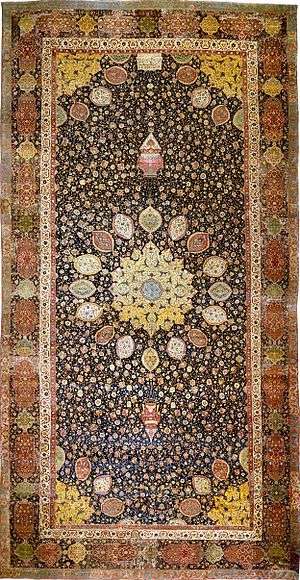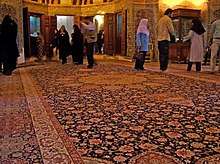Ardabil Carpet
The Ardabil Carpets (Ardebil Carpets) are a pair of famous Persian carpets[1][2] which made their way into the collections of the Victoria and Albert Museum in London and the Los Angeles County Museum of Art. They are examples of Ardabil rugs, products of the Safavid textile and manuscript influence. The carpets are typical Tabriz work, with one central medallion and smaller, ornate designs surrounding. Such medallions and shapes were central to the design and reality of Persian gardens, a common symbol of paradise for an Islam follower. [3]

Design
The foundation is silk with wool pile of a knot density at 300–350 knots per square inch (47–54 knots per cm2). The size of the London carpet is 34 1⁄2 by 17 1⁄2 feet (10.5 m × 5.3 m), which gives it about 26 million knots in total.[4] The carpets have an inscription: a couplet from a ghazal by Persian mythic poet Hafiz Shirazi and a signature.[5] The inscription reads:
I have no refuge in the world other than thy threshold.
There is no protection for my head other than this door.
The work of the servant of the threshold Maqsud of Kashan in the year 946.
Translating this date into the Christian calendar shows that the carpet was woven around the years 1539–40 during the reign of Shah Tahmasp, one of the great patrons of carpet weaving.
The design of the central medallion resembles that of the interior side of the dome of the Sheikh Lotfollah Mosque in Isfahan, with two differently sized lamp motifs surrounding the design, now seen as a deliberate use of graphical perspective, when looked at from the end with the smaller lamp the two appear the same size. However, a debate exists due to the fact that there is no proof that graphical perspective was used in 1530s Iran and other historians and critics instead believe the lamps are ones found in mosques or shrines at the time. The border is created from cartouches filled with decorations and calligraphy, adding even more details to the already accomplished style. [6]
History
Completed during the rule of the Safavid Shah Tahmasp I in the mid-16th century, probably in Tabriz, the carpets are considered some of the best of the classical Iranian (Persian) school of carpet creation. They were first placed in a mosque in Ardabil, but they had become heavily worn in Iran and were sold in 1890[3] to a British carpet broker who restored one of the carpets using the other and then resold the restored one to the Victoria and Albert Museum. William Morris advised the V&A in the acquisition.[7]

This carpet was sold by the dealer Edward Stebbing of Richardson and Company as "The Holy Carpet of the Mosque at Ardebil", stressing the "exceptionalism of the carpet and its provenance as a product of the Safavid royal atelier of Shah Tahmasp, made for the Safavid dynastic shrine at Ardabik”. Morris wrote in a letter to Thomas Armstrong that “it has no counterpart”. Gradually, word came out that there was a second Ardabil carpet. When the Victoria and Albert Museum began to check out the piece in 1914, the historical consensus came to be that the modifications on the current Los Angeles Ardabil to repair the London Ardabil were managed by Ziegler and Company, the first buyer of the carpets from Persian resident Hildebrand Stevens, supposedly using Tabriz or Turkish craftsmen. The second Ardabil had visible changes in its structure, as seen in the LACMA image, with its borders replaced into a newly woven narrow line while the London Ardabil was thoroughly over-restored. Historians of the time spoke to this, stating 'The highest market value was for complete carpets, rather than damaged ones or fragments. The London carpet was ‘a remarkable work of Art’, and as Morris has said, of real historical importance, but it had been compromised to suit the market values of 19th century art connoisseurship.' The carpet was for decades displayed hanging on a wall. Since 2006, it has been shown flat in a special glass pavilion in the centre of the Jameel gallery, Room 42 of Islamic art. The lighting is kept low to prevent fading.[8]
The second "secret" carpet, smaller, made up from the remaining usable sections, was sold to the American businessmen Clarence Mackay and was exchanged by wealthy buyers for years. Passing through the Mackay, Yerkes, and De la Mare art collections, it was eventually revealed and shown in 1931 at an exhibition in London. American industrialist J. Paul Getty saw it, and bought it from Lord Duveen for approximately $70,000 several years later. Getty was approached by agents on behalf of King Farouk of Egypt who offered $250,000 so that it could be given as a wedding present to his sister and the Shah of Iran.[9] Getty later donated the carpet to the Los Angeles County Museum of Science, History, and Art in the Exposition Park in Los Angeles. Other fragments have appeared on the market from time to time. The knot density is actually higher on the Los Angeles carpet.[10] It now resides in the Los Angeles County Museum of Art in Los Angeles. [4]

Influence
This Persian carpet has been the subject of numerous copies ranging in size from small rugs to full scale carpets. There is an 'Ardabil' at 10 Downing Street (the headquarters of the UK Government), and even Hitler had an 'Ardabil' in his office in Berlin.[7][11] Commercial copies of the carpet for sale range from prices of $200 to $45,000.
References
- Beattie, M. "ARDABĪL CARPET – Encyclopaedia Iranica". www.iranicaonline.org. Encyclopedia Iranica. Retrieved 1 January 2017.
- The Editors of Encyclopædia Britannica. "Ardabil Carpet". Encyclopedia Britannica. Retrieved 1 January 2017.
- Getty, J. Paul (2003). As I See It: The Autobiography of J. Paul Getty. Los Angeles: Getty Trust Publications. pp. 270–271. ISBN 978-0-89236-700-9.
- "The Ardabil Carpets". Jozan Magazine on Oriental Rugs. January 31, 2003. Archived from the original on February 9, 2007.
Sources: Los Angeles County Museum of Art, The Oriental Rug Lexicon by Peter F. Stone.
- Shahram Razavi. "The famous Ardebil Persian rug". WorldIsRound.com. Archived from the original on 2007-08-22.
- Hillier
- Hillyer, Lynda; Pretzel, Boris. "The Ardabil Carpet – a new perspective". Victoria and Albert Museum, Conservation Journal Spring 2005: Number 49. Archived from the original on 2007-02-07.
It was William Morris, in his capacity as one of the V&A's Art Referees, who persuaded the Museum to raise, with the aid of public subscription, the then vast sum of £2000 to purchase the carpet in March 1893.
- Hillier
- "J. Paul Getty buys art in Europe and the Pierre Hotel in New York". Raken.com. Archived from the original on 2007-09-14.
He [Getty] paid £14000 for the piece once declared “not for sale” by Lord Joseph Duveen. Years later [in 1938] he turned down an offer of $250,000 from King Farouk of Egypt, who wanted the rug as a wedding present for his sister, when she married the Shah of Iran.
- Hillier
- Jennifer Wearden (July 1995). "The Surprising Geometry of the Ardabil Carpet". Paper presented at Ars Textrina International Textiles Conference, University of Leeds. Victoria and Albert Museum.
External links
- Armstrong, Dorothy (2018). "Inventing the Ardabil Carpet: A Case Study in the Appropriation and Transformation of a Persian Artifact". Iran: Journal of the British Institute of Persian Studies. 58 (1): 110–130. doi:10.1080/05786967.2018.1547984.
- The Ardabil Carpet at the Los Angeles County Museum of Art